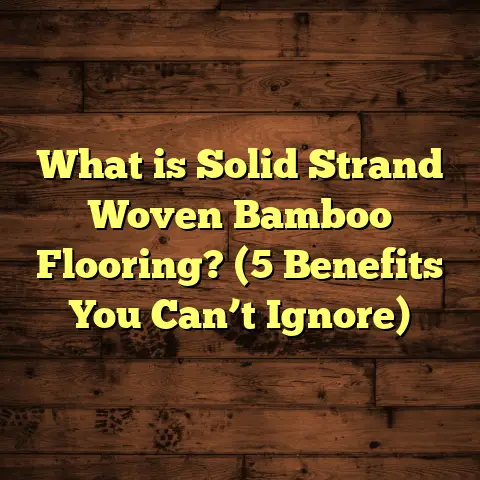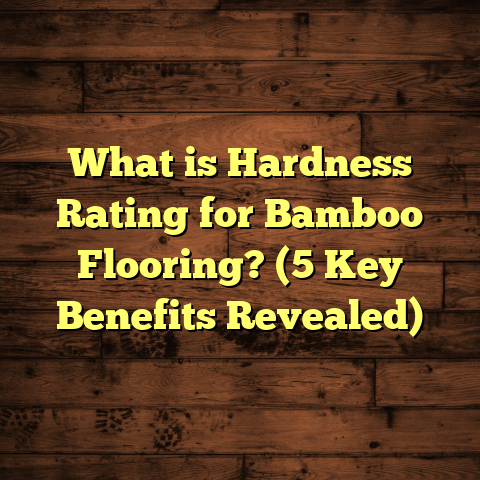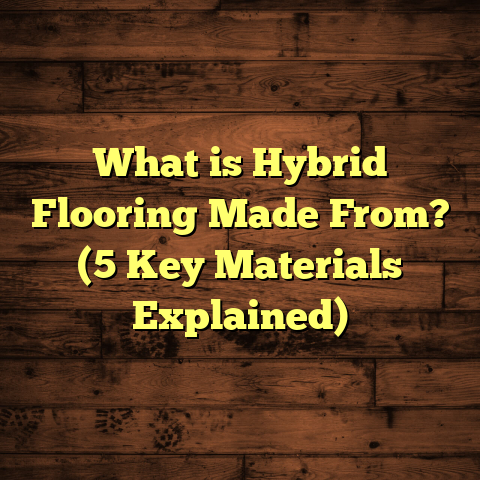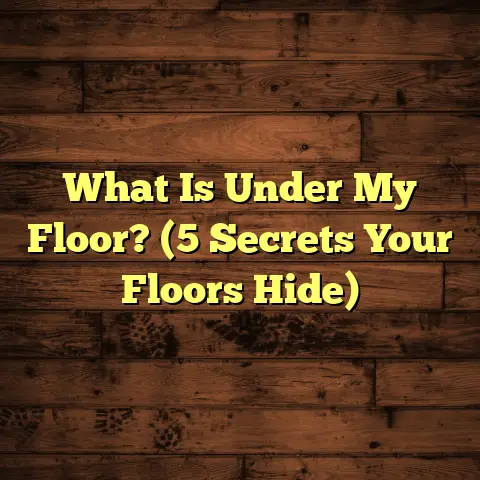What is Screening a Floor? (5 Key Benefits for Homeowners)
Imagine you’ve just moved into an older home with hardwood floors that tell the story of decades past. You love the character they bring, but as you walk across them, you notice some dullness, minor scratches, maybe a few squeaks here and there. You want those floors to look fresh again—but sanding the entire floor sounds like a massive project. What if there was a simpler way to breathe life back into those floors without all the dust and hassle? That’s where screening comes in.
I’ve been working with hardwood floors for years, and screening has become one of my favorite techniques to recommend to homeowners who want their floors refreshed quickly and affordably. It’s not as well-known as sanding, so I want to break it down for you: what screening actually is, why it’s useful, and how it can benefit your home.
What is Screening a Floor?
Screening a floor is a process used primarily on hardwood floors to prepare the surface for a new finish without completely sanding it down to bare wood. Instead of aggressively stripping away layers, screening lightly abrades or “scuffs” the existing finish using a fine abrasive pad or screen attached to a floor buffer.
Think about it like this: you know how sometimes you clean your kitchen countertop with a mild scrubber to remove stains and buildup without sanding off the surface? Screening your floor works similarly—it’s a gentle way to roughen up the surface so new finish can adhere properly without stripping everything away.
How does screening differ from sanding?
Sanding is the process of grinding down the wood itself to remove old finishes, scratches, and imperfections. It’s more invasive and removes a thin layer of wood along with the finish. It can reveal fresh wood beneath but also creates dust and requires more drying time after finishing.
Screening only targets the old finish layer. It doesn’t reach the wood underneath, so it’s less damaging but also less aggressive. Because it leaves the wood intact, you can screen multiple times over the years without wearing down your floors too much.
What tools are used for screening?
Typically, a floor buffer fitted with a fine abrasive screen or pad is used. These screens come in different grits—the finer the grit, the gentler the abrasion. The machine spins the pad over the floor, lightly scuffing the finish to create texture that helps new coats bond well.
There are also hand-held versions for small spots or touch-ups, but for full-room screening, a professional-grade floor buffer is best.
Why I Recommend Screening for So Many Homeowners
I remember one client who called me after noticing their once-beautiful hardwood floors looked tired and dull. They were worried about the cost and mess of sanding but wanted their floors to shine again. After inspecting their floors, I suggested screening as a first step.
The results? The floors looked revitalized, scratches softened, and the finish was smooth again—all completed in one afternoon with minimal dust. The client was thrilled they didn’t have to clear out their home for days or pay for expensive sanding.
Screening isn’t right for every floor situation, but when used correctly, it offers fantastic benefits:
1. Saves Time and Money
One of the biggest advantages I see with screening is how much time and money it can save compared to full sanding.
Why is screening faster?
Since screening only removes or roughens up the finish rather than grinding down wood layers, the process takes less time. You don’t have to move furniture out for days or wait long drying times. For a typical room of 300-500 square feet, screening can often be completed in just a few hours.
Cost savings in real numbers
Let’s talk dollars. On average:
- Screening and refinishing hardwood floors costs between $1.50 and $3 per square foot
- Full sanding and refinishing runs about $3 to $5 per square foot, sometimes even more depending on floor condition
For an average 500 sq.ft. living room:
- Screening might cost between $750 – $1,500
- Sanding might run $1,500 – $2,500+
That’s nearly double in some cases!
My experience with budgets
I rarely suggest sanding unless absolutely necessary because many floors just don’t need it if they’re not deeply scratched or stained. Screening helps keep costs manageable while still improving appearance dramatically.
For example, I helped a couple in Austin save over $1,200 by screening their floors rather than sanding after their dog scratched up some surface finish. The floors looked great again, and they didn’t break their budget.
2. Less Dust and Mess — A Major Relief
If you’ve ever seen or smelled freshly sanded floors, you know how much dust it creates. It infiltrates every corner of the house—furniture, vents, air filters—you name it.
How does screening reduce dust?
Because screening only lightly abrades the finish instead of grinding wood, it produces very little dust—mostly tiny finish particles that are easier to contain and clean up.
I’ve had clients thank me repeatedly for this benefit because they could stay in their homes during the work without worrying about covering everything or moving out temporarily.
Health benefits
Less dust means better air quality during and after work—especially important if you have asthma, allergies, pets, or kids. Some studies show that sanding airborne dust can contain harmful microscopic particles from finishes or old paint layers; screening avoids most of this risk.
3. Extends Your Floor’s Life Without Sacrificing Wood
Hardwood floors are durable but not infinite. Every time you sand them down, you’re removing some wood fibers—usually about 1/32” per sanding session.
Why does this matter?
If your floors are more than 50 years old or were sanded several times already, there might not be enough thickness left for another full sanding. That’s where screening shines because it doesn’t remove wood at all.
Real-world impact
I worked with a homeowner whose floors were original 1920s oak planks already sanded three times in their lifetime. They wanted to refresh without risking wearing them down further.
Screening allowed us to maintain the floor’s thickness while improving appearance dramatically. This approach can add decades of life before needing major refinishing again.
4. Quick Drying Time Means Faster Return to Normal Life
After sanding floors, you usually need to wait several days before walking on them safely due to deeper finish penetration and thicker coats applied.
Screening speeds up finishing
Because screening only affects the top layer of finish prep:
- New coats bond faster
- Drying times are shorter—often under 24 hours
- You can walk on your floors sooner
This quick turnaround is a lifesaver if you have busy schedules or can’t vacate your home during projects.
5. An Eco-Friendly Option
Environmental concerns influence many of my recommendations these days.
Less waste generated
Screening produces fewer airborne particles and less waste material since it doesn’t grind away wood fibers like sanding does.
Preserving natural materials
Keeping your hardwood intact longer means fewer trees harvested overall across flooring lifecycles. Also, less chemical use for cleanup and dust control reduces environmental footprint.
How Screening Fits into Your Floor Care Routine
If you want your hardwood floors to look good over long periods without costly overhauls every few years:
- Inspect floors regularly for wear signs (dullness, scratches)
- Screen and refinish every 3-5 years depending on use
- Reserve sanding only for when deeper damage occurs
This maintenance plan has worked wonders for my clients who get decades out of their original hardwood without full replacements.
When Should You Skip Screening?
Screening isn’t a fix-all solution.
If your floors have:
- Deep gouges or scratches
- Water damage or warped boards
- Stubborn stains embedded in wood grain
Then sanding or even partial board replacement may be necessary. Screening won’t remove these issues because it only targets surface finish layers.
A Closer Look: My Experiences with Screening vs Sanding
Over my 10+ years in flooring work, I’ve done hundreds of jobs involving both screening and sanding hardwood floors.
Some takeaways:
- Screening is perfect for routine maintenance and light wear
- Sanding is reserved for restoration when damage is severe
- Combining both methods sometimes works best—screen first to see if it solves issues before moving to sanding
- Communication with homeowners about expectations is key because results differ based on floor condition
One memorable project involved an older home with pine floors that had deep staining from pets over many years. We tried screening first but quickly realized full sanding was needed due to discoloration embedded in wood fibers.
Using Tools Like FloorTally Makes My Job Easier
Estimating flooring project costs accurately can be tricky—there are so many variables like size, materials, labor rates, waste factors…
I rely on tools like FloorTally for quick cost calculations tailored to local pricing—this helps me give clients realistic budgets upfront without surprises later on.
For example:
- Input room dimensions
- Select flooring type (hardwood with screening option)
- Factor in waste percentage
- Add local labor rates
FloorTally consolidates everything into one estimate quickly so I can focus more on quality work instead of chasing quotes from multiple suppliers and contractors.
What About Other Flooring Types?
Screening works best on finished hardwood floors but isn’t suitable for all flooring kinds like laminate or vinyl because those materials don’t have sandable wood layers underneath.
For engineered hardwood with a thick wear layer (over 3mm), screening can sometimes be done similarly to solid hardwood if recommended by manufacturer guidelines.
But if you have carpet, tile, or vinyl flooring — screening doesn’t apply at all since they have different maintenance needs.
The Science Behind Screening Abrasion
You might be wondering: why does roughing up the finish help so much?
New finishes need something to “grab onto.” If you apply fresh coats directly over smooth finishes without preparation:
- The new layer may peel or bubble because adhesion fails
- Floors won’t last as long before needing refinishing
Screening creates tiny microscopic roughness that improves mechanical bonding between old finish and new coatings.
Studies show that screened surfaces increase adhesion strength by up to 30% compared to unprepared surfaces—meaning your new finish holds better over time.
What Types of Abrasive Screens Are Used?
The grit level determines how aggressively the finish is abraded:
- Fine grit (like 100-120) is typical for light screening—ideal if finish is mostly intact
- Medium grit (around 80) if previous finish has more wear
- Coarser grits are rare but used cautiously if heavier abrasion is needed
I always test a small hidden area first to see how much abrasion is required before proceeding on entire floor space.
Tips for DIY Enthusiasts Thinking About Screening Floors
If you want to try screening yourself:
- Rent a quality floor buffer with proper screen pads
- Clear furniture and clean floor thoroughly before starting
- Work slowly and evenly across whole surface—don’t linger too long in one spot
- Wear protective gear: mask, eye protection because some dust will be released
- Follow new finish manufacturer instructions closely after screening
But honestly? Most homeowners find it easier and less stressful to hire pros who do this daily—they have experience avoiding uneven abrasion or damage.
Real Case Study: A Historic Home Saved by Screening
I once worked on a 1900s historic home where original maple floors had faded over decades but no major damage. The owners wanted to keep as much original character as possible while brightening surfaces.
We screened carefully using fine pads then applied three coats of oil-based polyurethane finish. The transformation was stunning—the floors glowed warmly under natural light without losing antique charm.
The owners appreciated how we preserved history without costly replacement or heavy sanding that could have thinned boards dangerously.
How Often Should You Screen Your Floors?
Frequency depends on traffic:
- Low traffic rooms: every 5+ years
- Moderate traffic: every 3-5 years
- High traffic areas like hallways: possibly every 2-3 years
Regular inspections help decide timing based on visible wear instead of sticking strictly to calendar dates.
Common Mistakes with Screening
From experience here are pitfalls I warn clients about:
- Trying to screen damaged or stained floors expecting miracles
- Using wrong abrasive grit causing uneven surfaces
- Skipping proper cleaning before refinishing leading to poor adhesion
- Applying finish too soon before floor is fully dry after screening
Avoiding these keeps your floor looking great longer.
Wrapping Up My Thoughts on Screening
Screening is an efficient way to refresh hardwood floors when they show signs of wear but don’t need full sanding. It saves money and time while reducing mess and preserving wood thickness.
If you want to maintain your floors’ beauty and longevity without breaking budgets or dealing with big disruptions—screening may be the perfect solution.
Questions about whether your floors need screening or sanding? I’m happy to help evaluate photos or details anytime!
FAQs About Screening Hardwood Floors
Q: Can screening remove deep scratches?
A: No—screening only affects finishes. Deep scratches require sanding or repair.
Q: How long does screening take?
A: Typically 2-4 hours for an average room depending on size and condition.
Q: Will screening change my floor color?
A: No—it only refreshes surface finish; color changes would come from stain or new finish coats.
Q: Can I do screening myself?
A: Possible but challenging without proper tools/experience; hiring pros usually yields better results.
Thanks for hanging out with me through this detailed look at floor screening! If you’re thinking about freshening up your hardwoods soon, maybe give screening a shot before jumping into costly sanding projects—you might be pleasantly surprised at what this simple step can do for your home’s warmth and charm.
Got stories about your flooring experiences? I’d love to hear them!





